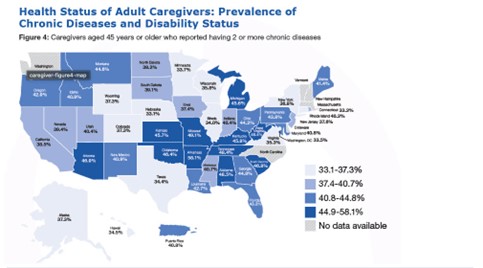Public Health’s Role in Supporting Family Caregivers
According to a September 2022 report by the National Alliance for Caregiving (NAC) and the National Association of Chronic Disease Directors, Chronic Disease Family Caregiving Through a Public Health Lens, there are 53 million family caregivers in America-that’s nearly one i five families. Furthermore, the number of caregivers will continue to rise as people aged 65 or older are expected to almost double by the year 2060. At that time, the nation will have reached a milestone of one in four people responsible for providing care for a family member with a chronic disease, serious illness, or a disability.
The report, which was supported by a grant from the John A. Hartford Foundation, found that caregivers are taking on caregiving responsibilities for adults with increasingly complex needs due to raising rates of chronic disease, Alzheimer’s Disease and other types of memory and dementia issues.
Caregivers in Need
Providing care for an ill family member is a demanding task often made more complicated by geographically dispersed families and the need for two wage-earners.

Source: Caregiving for Family and Friends – A Public Health Issue
According to a NAC and National Association of Chronic Disease Directors Roundtable, in 2020,23 percent of caregivers reported worsening health due to caregiving. Of those caregivers, 60 percent reported difficulty when addressing their own health needs. TFAH has recommended establishing a comprehensive paid family and medical leave policy that ensures paid time off to address family health or caregiving needs for all employees.
Equity in Caregiving
Of the nation’s 53 million family caregivers, an estimated 61 percent are Non-Hispanic white, 17 percent are Hispanic, 14 percent are African American, and 5 percent are Asian American and/or Pacific Islander. As the need for care grows, the need for caregiver systems that are integrated into the community, and culturally and language appropriate is critical. Innovations in technology, such as telemedicine and translation tools, can assist in allowing both long-distance and non-English speaking caregivers have the support they need from public health programs and their communities. Culturally designed approaches and relationship building within communities will enable greater understanding of, support for, and interaction with the nation’s caregivers.
How Can the Public Health System Support Caregivers?
Support for the nation’s caregivers is a public health issue especially in light of demographic changes that will make the need for family caregiving even greater in the future. The public health system has a critical role to play in supporting family caregivers and their ability to provide care through care coordination and assistance integrating home care with more formal healthcare services. Public health systems should work to create family caregiving support infrastructure and should team with other entities that can have a role in supporting caregivers including healthcare systems and providers, insurers, community-based organizations, faith-based organizations, and employers.
Conclusion
Caregivers are a vital part of the nation’s healthcare system and need the support of the public health sector. Policies should support the nation’s existing and growing number of caregivers to allow them to provide care while protecting their own health, well-being, and financial security.
Additional TFAH Age-Friendly Public Health Systems initiative Resources on Family Caregiving

